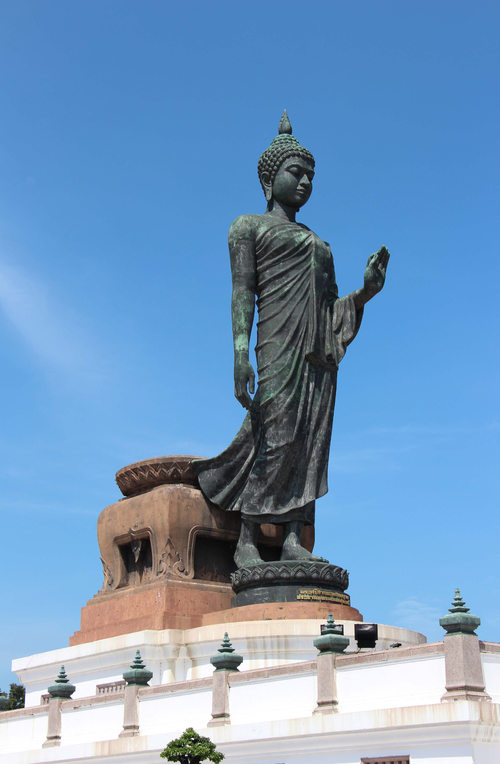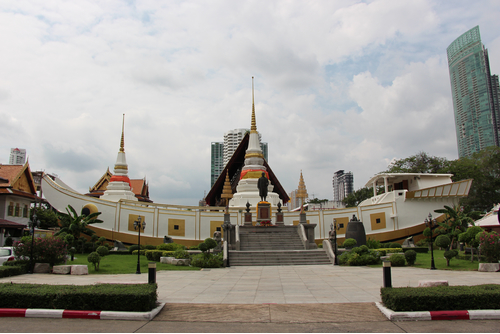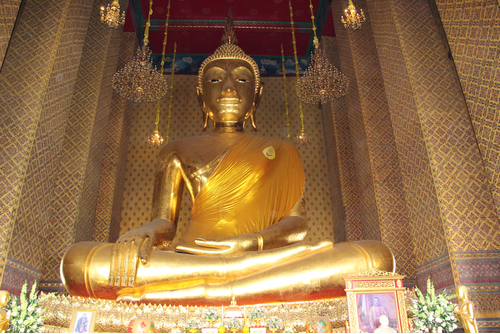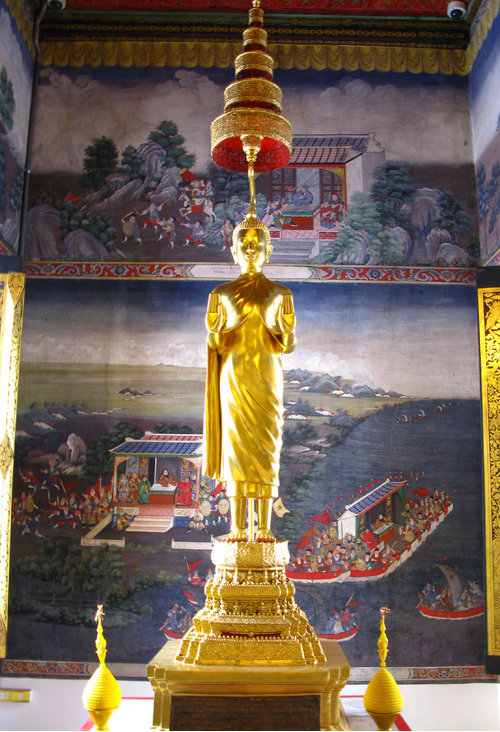Artwork Search
Arts in Southeast Asia Database
SculpturePhra Si Sakaya Dasabalayan Prathan Phutthamonthon Sudassana
It is a walking Buddha image on lotus base. The left hand is performing Vitarka Mudra. The face is oval-shaped rather round, like a real person. The hair is coiled into small spirals. There is the ushnisha under the flame halo. The ears are long. The image is wearing the robe across a shoulder with outer robe on the shoulder and the robe is wavy folded naturally. The edge of the robe is realistically attached to the rear throne.
SculpturePhra Puttha Manusanak
It is the standing Buddha image on lotus lion-footed base. King Prajadhipok initiative of building the Buddha is also inscribed on the base. Both arms are elevated. The palms are facing outward and the fingers are extended upwards or it is called the attitude of stopping the rainstorm. The fingertips are not even in length. The robe is worn covering both shoulders. The robe is wavy folded naturally worn over Sabong which also can be detected from the streak underneath. The wavy folded style of robes represents the realistic concept, however other features of the Buddha are still the same such as the calm face, low-glancing eyes, long ears, small hair coils, and there is a low Ushnisha under a flame halo and decorated with five-tiered golden perforated Chatra
ArchitectureThe Junk Vessel with Adorned Pagodas
The junk is made of bricks and stucco and similar to a Teochew junk. The bow is facing south to Chao Phraya River. The stern is facing north. The room on the stern enshrines the Buddha image and the Buddha footprint. A large adorned pagoda is enshrined in the middle and another small adorned pagoda is enshrined at the bow. The design of the adorned pagodas is composed of a set of three lion-footed bases with Bua Klum (a group of lotus petal) under the in bell-shaped part. The spire part is composed of a group of lotus petal vine, the tapering finial, and the topmost orb. An adorned pagoda is a style which was evident since the late Ayutthaya and was very popular in King Rama III period.
ArchitecturePhra Phuttha Prang
All three Prangs are on the same Paitee base (the shared ground base which supports many types of building together). The lower part of these three Prangs is the set of pointed-center lotus base. Ruean Dhatu of the principal Prang is the cruciform Mondop style. There are the sculptures of Giants standing and holding bats at the indented corners of Prang. The wall on the indented corners area is decorated with Kab Brahmasorn (a style of decoration on posts). The roof is a cruciform three-tiered tile roof. The roof is decorated with Chofa, in form of Nok Chao style (one head Naga), Bai Raka and Hang Hong in descending order. The spire has 6 tiers in stack decorated with tightly leaf-like petal sculptures. There also is a tier that is decorated with the angel sculptures putting the hands together on their chests, and the giant sculptures holding things over head motifs. Other two flank Prangs have the same forms. However, they are smaller. The roof has two tiers. The gables are plain triangles, no Nok Chao, Bai Raka, and Hang Hong.
SculpturePhra Si Ariya Mettrai
It is the Buddha image in royal attire. The robe is worn across the shoulder. The image is seated with the Siddhasana legs crossed which the right foot is placed above the left foot in the attitude of mediation. The face is quite round. The eyebrows are arched. The area between the eyelids line and the eyebrows is the sheets of eyelids. The eyes are quite small glancing low and not widely opened. The lips are small and also the hair coils. The body is slim. These are the Buddha image features in King Rama III period which could be compared to the Buddha image in royal attire during the same period of time in Wat Nang Nong.
SculptureThe four Buddhas
All four Buddha images have the same features which they are seated in the attitude of meditation on lotus lion-footed pedestal; the pattern of the upturned lotus is called Bua Wang (long sword-liked lotus petal motif); there are Pah Tip (the fabric hanging on the front of a Buddha image base) in front; the faces are quite round; the eyebrows are arched; the area between the eyelids line and the eyebrows is the sheets of eyelids; the eyes are quite deep set, slightly open and glancing low; the lips are small; the hair coils are also small; there is the flame halo overhead and the body is slim. These are the features of the Buddha image in King Rama III period.
SculpturePhra Phuttha Trai Rattana Nayok
Phra Phuttha Trai Rattana Nayok has specific styles of the Buddha image made in King Rama III period which the body is quite slim; the face is likely round-oval; the hair coils are small; the head has the flame halo; the eyebrows are arched; the area between the eyelids line and the eyebrows is the sheets of eyelids, similar to the Buddha image in the late Ayutthaya; the eyes are open and starring straight; the nose is quite small and prominent; the mouth is small and the lip line is a little bit curved nearly straight like Ruea Pratun (a boat with a roof cover); The face is like a figure; the image is seated in the attitude of subduing mara; the fingertips are slender and even in length; and the outer robe is big and placed upon the middle of the body.
SculpturePhra Puttha Panya Akka
The Buddha image is standing on the lotus lion-footed pedestal which there is the inscription of King Chulalongkorn’s royal initiative about building the Buddha image. The image is performing Pang Pratan Apai on both hands or it is called the attitude of stopping the rainstorm. Four fingertips are all even in length. The image wears the robe covering both shoulders but separated on the chest, the same style as the monks of Ramana Nikaya. The robe is wavy folded naturally worn over Sabong which also can be detected from the streak underneath. The wavy folded style of robes represents the realistic concept. The face looks young and calm like a real person. The ears are shrunken but other features of the Buddha are still the same such as the small tightly hair coils with the flame halo. It is decorated with perforated 5-tiered golden Chatra over the head.









